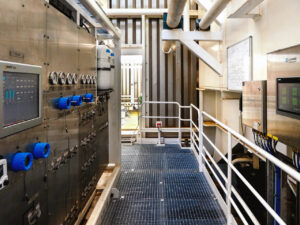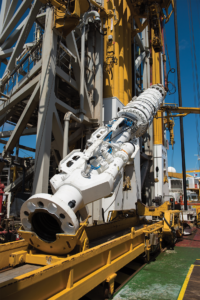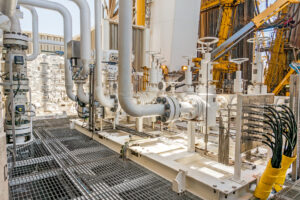Stena Drilling: A journey from zero MPD capability to fully integrated, ‘owned and operated’ MPD service
Having functionally identical systems across MPD fleet and taking collaborative approach to develop procedures cited as key success factors
By Nick Ward and Stuart Wyse, Stena Drilling

Responding to a competitive deepwater rig market, as well as operators’ increasing requests for managed pressure drilling (MPD) capability in rig tenders, Stena Drilling identified a requirement to establish MPD capability within its deepwater fleet and, in February 2016, sanctioned the purchase and integration of two deepwater MPD systems.
Since then, the company has successfully utilized both systems to drill seven deepwater MPD exploration and appraisal wells across multiple regions and for multiple operators.
Following the successes of the first two MPD systems, a third system was approved in 2019, with three additional MPD wells sanctioned for 2020 across the company’s newly instated MPD-capable fleet.
This journey from “MPD curious” to providing a fully integrated and proven operational MPD service has been the result of significant technical and operational achievements by Stena Drilling’s teams, in close collaboration with the MPD systems OEM, the vessels’ classification authority and major operators.
The MPD service model
Following dialogue with the industry, it became apparent that for deepwater MPD operations, operators increasingly wanted to move from a rental MPD service – with its higher mobilization and integration costs – toward a fully integrated, drilling contractor “owned and operated” operational service, offered as part of the wider rig service.
This was also identified by Stena Drilling’s management as the preferred solution as, having had brief experience with rental MPD systems in 2014, it was clear that assuming ownership and responsibility for the MPD system was the only way to give the drilling contractor the risk assurance it desired when engaging in such a critical well activity.
Stena’s integrated MPD service model provides the operator with a rig equipped with all necessary systems, competent personnel and detailed procedures required to perform all aspects of deepwater MPD operations. The model provides a purpose-built system that conforms to the same design, installation and maintenance standards as the wider rig, in line with classification, industry and regulatory rules.
The system is maintained and operated by the drilling contractor’s crew using a combination of existing rig crew up-skilled for MPD operations, as well as new MPD positions, namely MPD toolpushers and control system operators. These trained and competent crews deploy and operate the MPD system per Stena’s MPD operating procedures and in line with the operator’s well program, ensuring a consistent approach with more assured outcomes.
System design
In March 2016, a front-end engineering design study was commissioned, engaging MPD service providers, drilling contractor technical and operational personnel and MPD equipment manufacturers. The scope was to:
- Accurately define key project requirements;
- Encapsulate learnings from previous projects and systems; and
- Generate functional design specification and P&ID for a drilling contractor owned and operated modular MPD package.
In addition, the MPD package would be designed to fulfil DNV-GL DRILL (MPD) classification requirements, a process which assesses all component roles within the system in an operational environment, as well as the effect on existing systems onboard, ensuring that the isolation, redundancy and safety systems meet the standards to qualify for the DNV-GL DRILL (MPD) notation.

The design review process was kicked off in June 2016 in the form of hazard identification (HAZID) and hazard and operability (HAZOP) studies. The objective was to identify and document the hazards and operability issues occurring as a result of the intended range of process conditions of the MPD system. This was achieved by using a balanced and cross-functional team with extensive operating and engineering experience from the equipment manufacturer, drilling contractor and DNV-GL.
A key learning from the HAZID/HAZOP study was related to the pressure relief valve philosophy, where the overall system pressure relief valve requires to fail-as-is, rather than fail-close or fail-open, which is typically the standard product offering.
In July 2016 a DNV-GL Technology Qualification workshop was conducted to identify existing and new technology being adopted within the MPD system. For any new technology identified, a failure mode, effects & criticality analysis was performed to identify potential failures that could affect the performance of the MPD system.
Following delivery of the individual system components in March 2017, a system integration test (SIT) of the integrated riser joint (IRJ) and topside controls took place at the OEM facility. Testing included full electrical and hydraulic function testing through topside controls, network integrity testing, interlock verification, failure testing and simulated operational tasks – i.e. running/pulling of rotating control device (RCD) bearing. In addition to SIT testing, a field wet-test of the IRJ and topside controls was performed in May 2017 onboard a warm-stacked unit in the Gulf of Mexico, providing an opportunity for the drilling contractor to train rig crews, capture lessons learned and develop detailed equipment operating procedures. The lessons learned from the field wet-test would prove invaluable during first deployment of the MPD system later that year.
As part of the integration with the rig design, quasi-static analysis was performed to verify that hose bend radii and twists were within allowable limits for the specified 180° vessel weathervane at both fully extended and fully retracted positions of the telescoping joint. A two-stage hydrodynamic analysis and wave fatigue analysis of the hose steel reinforcement plies was also performed, using drillship motion response during harsh-environment conditions.
Hydrodynamic analysis showed that all bending radii remained above the allowable minimum bend radius limit, and hose twists did not reach the limit for any load cases. Critical to this analysis is the understanding of swivel breakout torque for the pressurized and unpressurized load cases, which can have a significant impact on hydrodynamic analysis.
Hose analysis also resulted in the consideration for external hose protection at critical areas to avoid excessive hose clashing with the drilling riser and vessel structure. Fatigue analysis results showed expected service lifetimes greater than the required 150 years according to API 17K.
To integrate the MPD system onto the drillship, detailed 3D laser scanning techniques were adopted to allow for MPD piping, piping supports and structural foundation designs to be generated offline. Piping isometrics were produced and pipe stress analysis performed.
In addition to pipe stress analysis, flow and erosion analysis was completed in accordance with DNVGL-RP-0501: Recommended Practice for Managing Sand Production and Erosion. As the MPD system has been designed to be used on many different projects, operating conditions were selected to reflect the range of operations which the MPD system is likely to encounter. Computation fluid dynamics was used to provide absolute erosion wear values for particular areas of concern; i.e. pipe bends, weld joints, flexible piping, chokes, etc.

Following field wet-testing and installation of all main piping and electrical runs, the MPD package was mobilized to Guyana. Over 62 days, the MPD system was installed during ongoing drilling and well testing operations. This required careful planning between the drilling contractor’s MPD project team and operational personnel to ensure rig operations were not impacted, while maintaining a tight MPD installation schedule.
Final integration of the MPD system with the existing rig systems, commissioning of the MPD system and client/class acceptance activities were completed in August 2017 during a 10-day between-well window. This allowed for critical piping tie-ins to the rig’s choke and kill manifold, mud gas separator (MGS) and standpipe manifold, as well as final electrical tie-ins to the mud pump variable speed drive, to be completed.
Commissioning activities included full deployment and testing of MPD equipment, surface flow-loop testing through MPD chokes using various MPD software modes, pressure testing of equipment and system failure checks (simulated choke plugging and loss of a MPD pressure transmitter).
System description
Consistency of design, as well as using a single equipment supplier for the MPD system, was identified by Stena as critical to the success of the wider service model. Ensuring all MPD systems across the company’s MPD fleet are functionally identical – using the same control systems, hardware and layouts with a single OEM for support – provides significant efficiencies in the management and continuous improvement of MPD operations. It further helps to ensure crew competency and provide operational assurances. The closed-loop, below-tension-ring MPD system incorporates some of the industry’s most advanced MPD technologies and has been proven to deliver successful MPD wells consistently since 2017.
The IRJ is a single 40-ft assembly weighing just under 77,000 lbs, with a maximum outer diameter of 56 in. and minimum inner diameter of 18.77 in. The joint consists of a 18 3/4-in. RCD housing, a 21 1/4-in. slimline annular and a flow spool with dual outlets on the bottom. An adaptor spool (top) and integral flanged connection (bottom) allow quick and easy makeup to the rig’s riser system.
The joint is deployed below the tension ring but above the termination joint for the riser auxiliary lines (choke, kill, boost, conduit, etc). This means the IRJ itself has no external auxiliary lines, reducing its overall weight and aiding general handling and maintenance on all drill-through components.
Two 6-in. flowline hoses connect the IRJ via the flow spool to the surface distribution manifold, with a 2-in. bleed line running from a port between the RCD and slimline annular to the distribution manifold. A control umbilical connects to the joint to the surface control system via an umbilical reel.
The surface system consists of a main distribution manifold connecting the MPD system to wider rig systems, including standpipe and choke manifolds, the shale shakers and MGS. Immediately downstream of the distribution manifold is a junk catcher manifold featuring dual junk catchers intended to protect sensitive equipment downstream from plugging/damage.
Downstream of the junk catcher, the MPD choke manifold consists of two parallel 6-in. bodied, hydraulically actuated chokes, which can be dressed for 4- or 6-in. service. An additional 3-in. hydraulic choke is located upstream of the junk catcher, providing pressure relief if the junk catcher plugs.
All three chokes in the system work in concert to provide a tiered pressure control functionality. A flowmeter manifold is located downstream of the MPD choke manifold, incorporating two parallel Coriolis flow meters, which can be operated in tandem if required for higher flowrates. Equivalent, high-accuracy flow measurement into the well is provided by four individual Coriolis meters installed on the rig’s mud pumps. Finally, a set of automated valves downstream of the flowmeter manifold allows automatic routing of the flow to either the shakers or the MGS, as required by operations.
A central control unit provides power and control to a variety of subsystems, including the IRJ and the MPD chokes. An independent pressure relief system provides emergency pressure relief across the entire MPD system, including overall system protection and diversion overboard and individual component protection as required.
Procedural development & crew training
More than 45 procedures have been developed to cover the deployment, configuration, operation and maintenance of the MPD system. It was established very early on that all procedures related to the MPD system had to be authored and owned by the drilling contractor, written in a format and operational language familiar to the rig crews that would be assuming responsibility for MPD operations.
While this was the case, the development of these procedures was a collaborative process involving Stena, a major operator, an MPD service company (in their capacity as both the MPD system OEM and the operator’s MPD engineering provider) and a third-party MPD consultancy. Even at the rig site, this collaborative approach to procedural development continued, with lessons learned captured daily during early operations and continued redraft, review and update. Bringing together this wide range of expertise, objectives and perspectives utilizing a collaborative and iterative approach delivered a suite of procedures that has delivered safe, efficient and consistent MPD operations across multiple vessels and challenging wells.
These procedures subsequently became fundamental to the in-house MPD training program that Stena provides its crews in preparation for MPD operations. Personnel initially undergo an intensive two-day classroom training, giving them detailed understanding of MPD fundamentals, equipment, methods and procedures.
Critically, all training is built around the specific system, equipment and associated procedures the crew will work with on their own rig – a key benefit of maintaining a consistent approach to MPD system design and functionality. This removes any uncertainty that might come with a more generic, “catch-all” training program.
Following this classroom training, a two-day simulator course, again fundamentally built around the actual procedures the crews will use at the rig site, gives the MPD personnel a chance to “feel” the differences between MPD and conventional drilling, as well as challenge themselves in contingency and emergency scenarios in a controlled and safe environment.
A final level of rig-based training performed in the casing shoe prior to drill-out provides an opportunity to observe the actual system reacting in a number of scenarios and procedures before the MPD system is utilized for critical well operations.
Operational experience
To date, Stena Drilling has installed MPD systems on the Stena Carron and Stena IceMAX drillships, drilling seven MPD wells in less than 24 months across both vessels. Five of the seven wells have been drilled utilizing hydrostatically underbalanced fluid, with the drilling contractor and operator prepared to perform dynamic well control, removing influx via the riser where this is deemed safe by the influx management envelope. The MPD system has been utilized in a variety of sections from 8 1/2-in. up to 19-in. hole, across a wide range of drilling parameters and flow rates.
“It was clear that assuming ownership and responsibility for the MPD system was the only way to give the drilling contractor the risk assurance it desired when engaging in such a critical well activity.”
The system has been utilized to achieve constant bottomhole pressure during drilling, connections, tripping, coring, wireline and BOP testing operations, as well as facilitating the performance of dynamic leak-off tests, pore pressure tests and drilling problem management (losses, etc).
Both rigs have been primed for pressurized mud cap operations. However, to date, no suitable formation has been encountered to allow conversion to the technique. Since August 2017, Stena Drilling’s MPD fleet has spent more than 600 days on MPD wells, deploying the RCD’s bearing assembly (or wireline logging adapter) a total of 58 times.
Stena will upgrade its third drillship, the Stena DrillMAX, to MPD capability in June 2020 and drill two appraisal wells in Q3/Q4. The remaining deepwater drillship in the fleet, Stena Forth, will be converted to DNV DRILL (MPD) with the installation of MPD pipework and ancillary services, ready to convert to full MPD capability as the market and contracts dictate. Finally, the Stena Carron is scheduled to drill its fifth MPD well this summer, ensuring the fleet will have averaged more than three MPD wells a year over the past three years.
Proven MPD service provider
In just under three years, Stena Drilling has gone from zero MPD capability to providing a full operational MPD service worldwide, allowing major operators to meet their deepwater MPD objectives safely and efficiently. This model provides economies, efficiencies and opportunities that can unlock deepwater reserves that had been considered uneconomic or technically unfeasible to drill.
As operators continue to seek out the lowest dollar-per-barrel projects, it’s predicted that deepwater MPD will be a key enabler, with the owned and operated MPD service adopted by Stena Drilling representing many operators’ preferred model. DC




